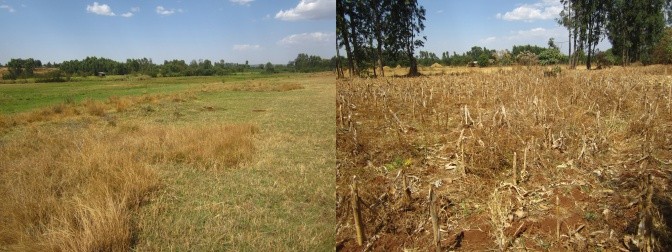Abandoning exhausted farm plots to seek more plentiful soils elsewhere is an age-old response to a well-known problem. But there’s a catch: not only are ever-growing shares of degraded land being left behind, the supply of healthy land also eventually runs out.
In Ethiopia, land degradation is a serious problem and a significant threat to the country’s future. Years of unsustainable farming practices have depleted the land, and farmers have begun to annex marginal lands to sustain their production, further aggravating the degradation of the landscape.
In response, the Ethiopian government has launched a number of promising programs to restore agricultural lands. However, the biggest challenge remains: how to ensure the sustainability of such interventions? One WLE research project in the Nile and East Africa region is working to identify incentives to support farmers to adopt long-term conservation approaches, assess benefits and trade-offs of interventions, and advice policy makers.
Livestock grazing freely on communal lands is a major contributor to the degradation of lands in all of Ethiopia, including in the Birakat watershed in the northwestern part of the country.
To alleviate the pressure from grazing animals, the Ethiopian government is promoting a new cut-and-carry system in Birikat and select other locations, in which fodder is cut from communal lands and carried to livestock that are fed in stalls. Grass is cut for hay once or twice a year, depending on the productivity of the grazing land, and it is then stored to be able to feed animals during the dry seasons. This grazing land management system has restored degraded communal lands in the Birakat watershed.
In addition, keeping livestock away from the communal lands prevents the animals from destroying other infrastructure put in place to conserve land and water, such as soil bunds and trenches on agricultural lands, terraces and grass strips. The cut-and-carry system also increases the amount of livestock fodder available and leaves more crop residues on the fields, which in turn improves soil fertility through increased carbon input.

Sustaining the win-win benefits of improved grazing land management requires long-term management and planning, and the WLE research project ‘Sustaining Land Resources Management Interventions in Ethiopia’ is working to generate science-based information that might guide policy makers and land managers, helping them to ensure better management of land.
Particularly, the project is working to identify incentives that support the local communities to adopt long-term conservation approaches, and it is testing gully rehabilitation technologies that may also help improve the overall health of the landscape.
Institutional innovations may amplify the benefits of improved grazing land management. For example, organizing landless youth and women’s groups and involving them in livestock fattening or dairy production could both serve as income-generating activities for these marginalized groups and quickly improve local community’s incomes and livelihoods, thus increasing the incentives for them to maintain sustainable land management practices. These kinds of initiatives have already been started in some watersheds, and this project will test the effectiveness of these kinds of short-term incentives to sustain natural resource management interventions.
Restoring degraded ecosystems, and increasing and sustainably harnessing the services they provide, is a key prerequisite for the advancement of the country’s agricultural sector. With the right approach, land restoration practices will also have positive effects on social, economic and biodiversity factors.
WLE funded project “Sustaining Land Resources Management Interventions in Ethiopia” aims at supporting the Ethiopian government by finding ways to further improve, and not least sustain, better land management practices. Ultimately, it aims to help local communities improve their incomes and livelihoods, while ensuring that generations to come may also benefit from healthy ecosystems.
















